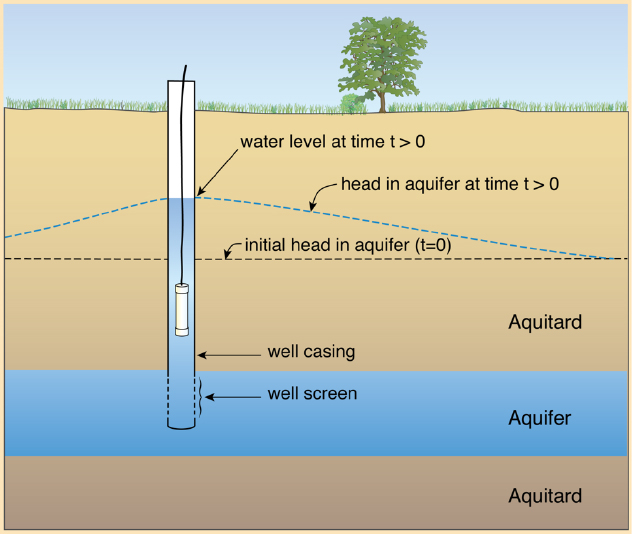
The water level temporarily rises above the initial head (water level) when an object is dropped into the well during a slug test.
News Release, Kansas Geological Survey, February 3, 2020
LAWRENCE — A simple and economical method used to evaluate a range of groundwater-related problems, from contamination to water-well deterioration, is the focus of a newly revised book by Kansas Geological Survey senior scientist Jim Butler.
Known as a slug test, the method is initiated when a solid object is dropped into the well or another means is used to produce an abrupt change in water level. The speed at which the water level returns to static conditions is then measured to determine the hydraulic conductivity of the formations immediately adjacent to the well. Hydraulic conductivity is the property that characterizes how easily water flows through subsurface rock and sediment.

The water level temporarily rises above the initial head (water level) when an object is dropped into the well during a slug test.
"Test results can be used to predict the movement of a subsurface contaminant - and the threat that contamination poses to neighboring water users - and to design plans for cleaning up the contamination," Butler said. "It is also used for a variety of additional purposes, including assessing the hydraulic conductivity of geologic units that are thought to be barriers to contaminant movement, for which few other methods are available."
Although slug tests are primarily used by scientists and engineers working at sites of suspected groundwater contamination, they are also used in a variety of other assessments related to agriculture, oil and gas exploration, wetlands, and glaciers.
Butler wrote the first edition of "The Design, Performance, and Analysis of Slug Tests" because too often improper procedures used during slug tests led to unreliable results and skepticism about the effectiveness of the method itself.
"Given the prevalence of the technique and the economic magnitude of the decisions that can be based on its results, there was a need for a reference text to which the research and practitioner communities could refer for answers to questions concerning all aspects of the design, performance, and analysis of slug tests," Butler said. "The purpose of this book is to fill that need and to place the slug test on much sounder theoretical and practical footings."
Tens of thousands of slug tests are performed each year in the United States and across the globe, and Butler's book remains the standard reference for scientists, engineers, and the environmental industry. Now, 22 years since its release, this new edition incorporates many advances, including new methods developed by Butler and colleagues at the Kansas Geological Survey.
More than two-thirds of the book was completely rewritten for this edition, he said, while the rest was significantly revised.
"The primary driver for my writing of this second edition was to have a reference text that is better positioned to stand the test of time." Butler said.
The Kansas Geological Survey is a research and service division of the University of Kansas. Besides groundwater investigations, especially in the High Plains aquifer underlying much of western and central Kansas, KGS researchers study and provide information on rocks, minerals, fossils, oil, natural gas, earthquakes, and other natural resources and hazards. The main headquarters of the KGS is in Lawrence, and the Kansas Geologic Sample Repository is housed at KGS-Wichita.
Contact: Cathy Evans, (785) 864-2195.
Kansas Geological Survey, Public Outreach
URL="http://www.kgs.ku.edu/General/News/2020/butler_book.html"